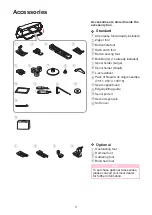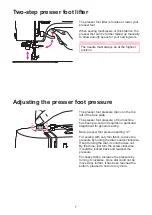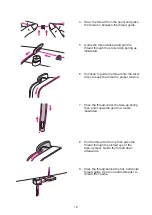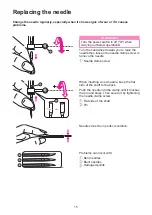
16
Matching needle/fabric/thread
Note
-
In general, fine threads and needles are used for sewing fine fabrics, thicker threads and
needles are used for sewing heavy fabrics.
- Always test thread and needle size on a small piece of fabric which will be used for actual
sewing.
- Use the same thread for needle and bobbin.
-
Use a stabilizer or place a backing for fine or stretchy fabrics, and select the correct
presser foot.
- It is recommended that a 90/14 needle should be used when embroidering on heavyweight
fabrics or stabilizing products (for example, denim, puffy foam, etc.). A 75/11 needle may
bend or break, which could result in injury.
-
For transparent nylon thread, always use needle 90/14 - 100/16. The same thread is
usually used for the bobbin thread and upper threading.
FABRICS
THREAD
NEEDLE SIZE
Light
weight
Thin cottons, voile, serge,
silk, muslin, Qiana,
interlocks, cotton knits,
tricot, jerseys, crepes,
woven polyester, shirt &
blouse fabrics.
Light-duty thread in cotton,
nylon, polyester or cotton
wrapped polyester.
65/9 - 75/11
Medium
weight
Cotton, satin, kettleclote,
sailcloth, double knits,
lightweight woolens.
Most threads sold are
medium size and suitable
for these fabrics and needle
sizes.
Use polyester threads on
synthetic materials and
cotton on natural woven
fabrics for best results.
Always use the same thread
on top and bottom.
80/12
Medium
weight
Cotton duck, woolen,
heavier knits, terrycloth,
denims.
90/14
Heavy
weight
Canvas, woolens, outdoor
tent and quilted fabrics,
denims, upholstery material
(light to medium).
100/16
Summary of Contents for NC-59QD
Page 1: ...Instruction Manual NC 59QD NecchiAIO Enjoy your Necchi time...
Page 2: ......
Page 7: ...Machine Introduction...
Page 11: ...Machine Setup...
Page 26: ...Sewing Basics...
Page 36: ...Utility Stitches...
Page 56: ...Maintenance and Trouble shooting...
Page 61: ......
Page 62: ......
Page 63: ......
















































